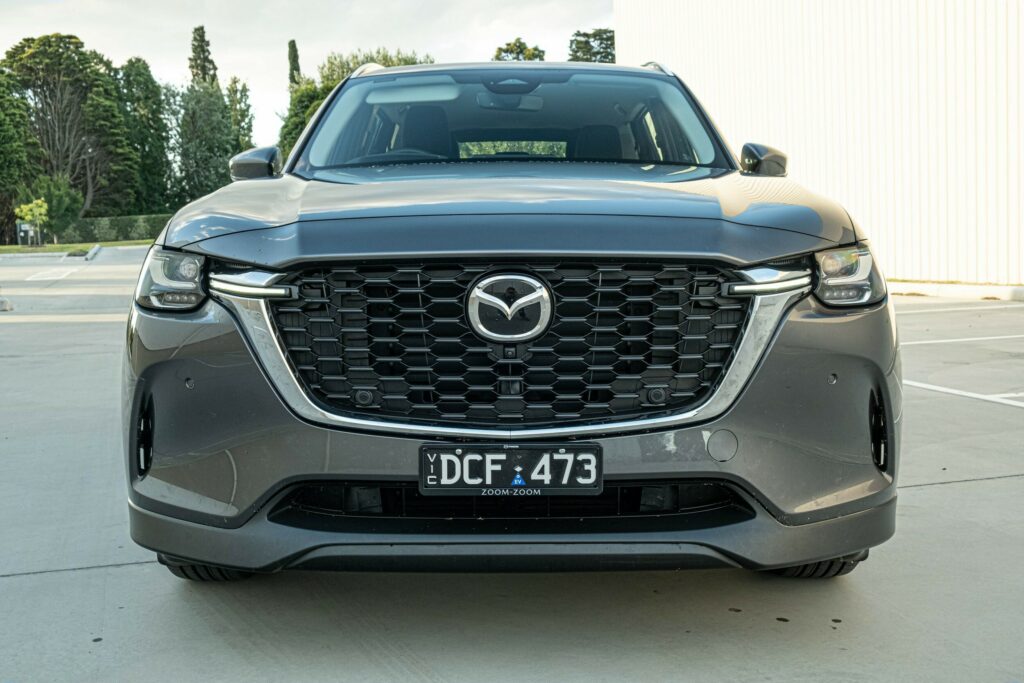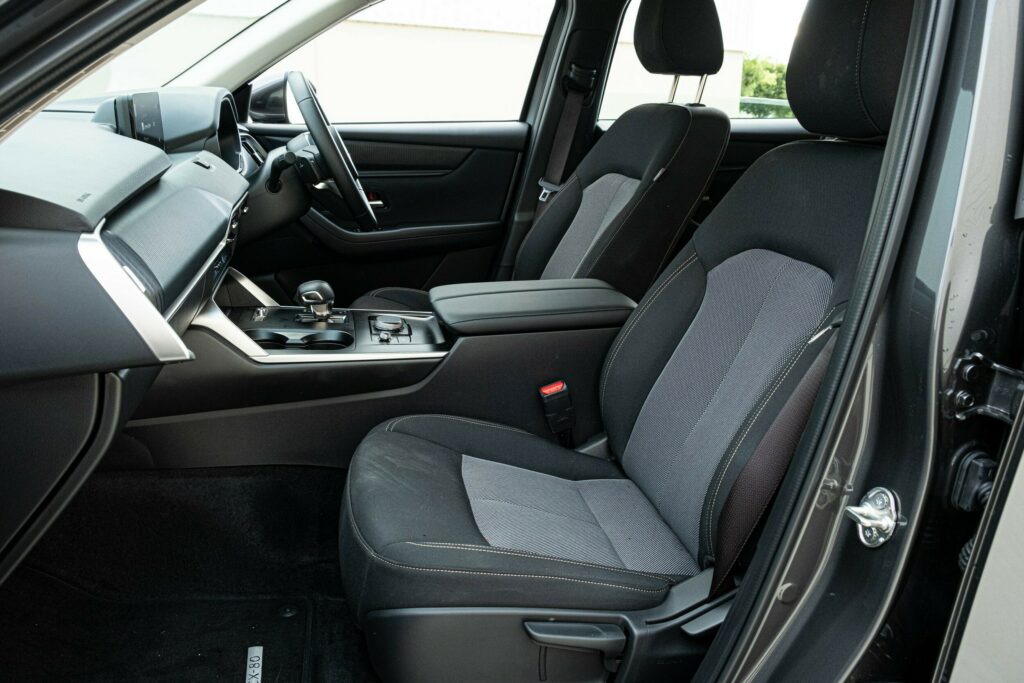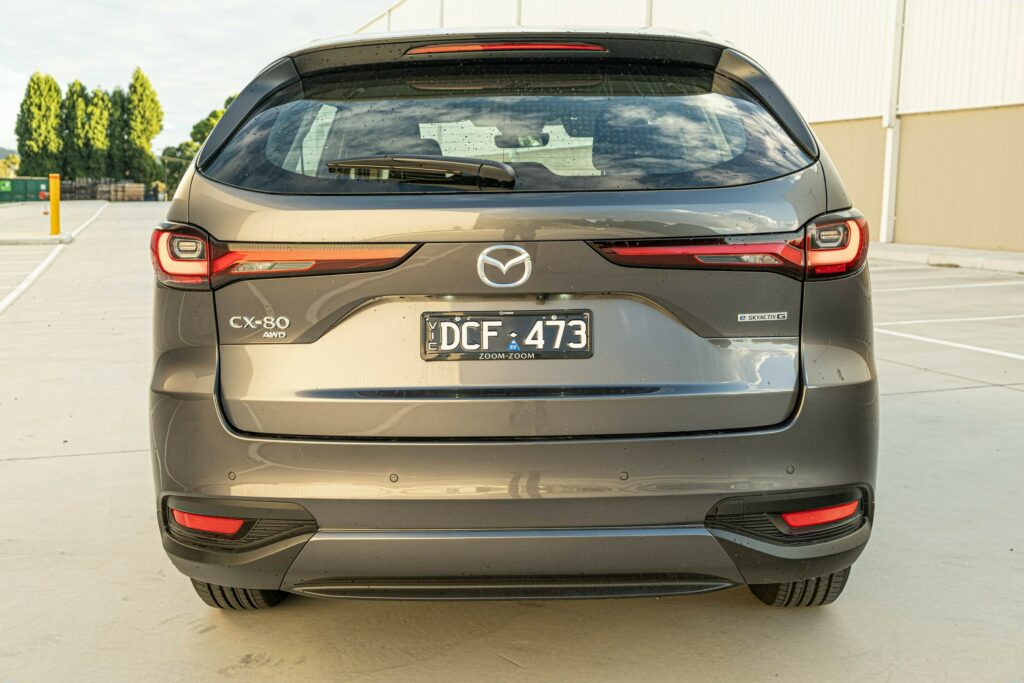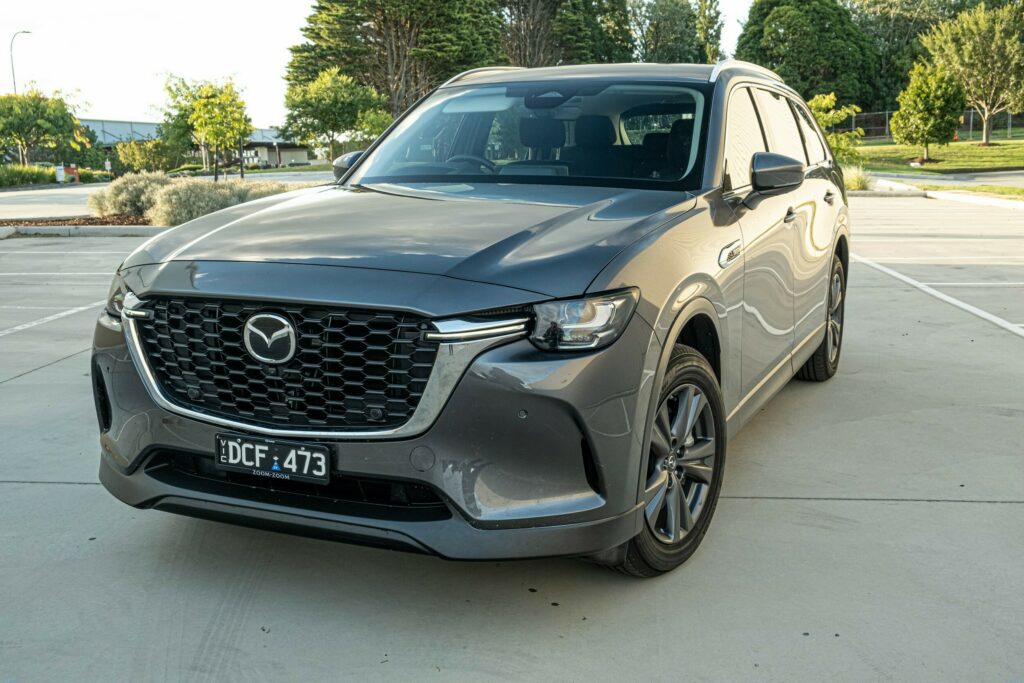Mazda has spent the last few years quietly climbing the ranks, gradually shedding its image as a budget-friendly brand and embracing a more premium approach. This push towards the luxury market is especially evident in their new lineup of global SUVs, which have clearly been designed with more discerning buyers in mind.
Review: The 2025 Nissan Armada Is A Luxurious Body-On-Frame Battleship
Among the standouts in this new breed of Mazda SUVs are the CX-50, CX-60, CX-70, CX-80, and CX-90. If you’re in the US, you’ll find the CX-50, CX-70, and CX-90 making their presence known. However, if you happen to be in Australia, the CX-60, CX-70, CX-80, and CX-90 all sit comfortably on the showroom floor together, offering a full spectrum of choices for those looking to upgrade their ride.
Last year, we took the CX-60 and CX-90 for a spin, getting to know them inside and out. More recently, we’ve spent some time behind the wheel of the CX-70 and CX-80. Today, though, we’re diving into the CX-80, an SUV that, despite its name, is essentially just a three-row version of the CX-60. Yep, it’s all rather confusing, but don’t worry—we’ve broken down the entire lineup in a separate post to clear things up.
QUICK FACTS
Photos Brad Anderson/Carscoops
Our Review Model
We tested the CX-80 in entry-level Pure guise. This model starts at AU$60,441 (~$38,000) and is the cheapest seven-seater in Mazda’s local range. The CX-80 is also offered in Touring (AU$67,735 / $42,600), GT (AU$75,029 / $47,200), and Azami (AU$80,447 / $50,600) trims. There are also several different powertrains to choose from.
Our tester was equipped with the entry-level 3.3-liter turbocharged inline-six gasoline unit in G40e guise. This engine delivers 280 hp (209 kW) between 5,000 and 6,000 rpm as well as a solid 450 Nm (332 lb-ft) of torque between 2,000 and 3,500 rpm. There’s also a diesel version of this same 3.3-liter on offer, rated at 251 hp (187 kW) at 3,750 rpm and 550 Nm (406 lb-ft) between 1,500 and 2,400 rpm. This was our first time testing the gasoline 3.3-liter, as both the CX-60 and CX-90 we tested last year had the diesel. Both the 3.3-liter models also have a 48-volt mild-hybrid system as standard.
Read: Mazda Inline-Six Rumor For New GR Supra And RX-7 Sounds Too Wild To Be True
Those seeking maximum efficiency and power can opt for the 2.5-liter four-cylinder plug-in hybrid. It pumps out an impressive 323 hp (241 kW) at 6,000 rpm and 500 Nm (369 lb-ft) of torque at 4,000 rpm. Regardless of the engine, all models are sold standard with an eight-speed automatic transmission and have all-wheel drive.
A key rival to the CX-80 is the latest-generation Hyundai Sante Fe. It, too is offered in petrol and hybrid guises, with prices kicking off from AU$58,000 (~$36,400) and tops out at AU$78,000 (~$49,000).
Photo Brad Anderson/Carscoops
Is The Interior Premium Enough?
Jumping inside the CX-80 Pure for the first time, there’s no mistaking the fact that this is the entry-level version. It can only be configured with black cloth seats that look a little cheap when compared to the rest of the cabin.
However, there’s plenty going for the cabin of the CX-80. Soft-touch black leather adorns the steering wheel, dashboard, door panels, and center console. It’s also a relief Mazda has used simple matte black plastic on the console, rather than the piano black surfaces you’ll find in some other models. There is also a 10.25-inch infotainment display with a 360-degree view monitor, and is complemented by a seven-inch in the center of the cluster, flanked by traditional dials. Wireless Apple CarPlay and Android Auto are included as standard, as is a driver monitoring system, an auto-dimming rear-view mirror, and blind spot monitoring.
The front seats, in addition to being trimmed in cloth, only offer manual adjustment. Yes, we get this is the base model, but electric seats should be standard at this price point. Fortunately, the seats are incredibly plush, particularly the base. This makes them nicely suited to long highway journeys, even though the lack of adjustable lumbar support is a noticeable omission.

The gauge cluster is the same as you’ll find in many other Mazda models, and while it offers a few different settings for the central display, there aren’t many customization options on offer. Similarly, Mazda’s current infotainment system is starting to feel a little tired and bland, particularly compared to some of its rivals. It’s also not a touch screen, meaning you have to use the (somewhat irritating) rotary controller on the console.
Read: Mazda Spirit Racing CX-60 Rally Concept Sports A Rear Spoiler And Carbon Recaros
Mazda has nailed the second row. While this is the base model, there are two USB-C charging ports back there as well as HVAC controls. Legroom and headroom are more than adequate for adult passengers, and there’s an option to tilt the backrests. There’s a surprising amount of space in the third row, too, and occupants back there have access to charging ports and cupholders. Headroom is an issue for taller people, but the rear seats are more than big enough for children and teenagers.

While we doubt many CX-80 customers will tow with their SUVs, the base G40e Pure can lug a respectable 2,500 kg (5,511 lbs), enough to tow a medium-sized caravan. Rear cargo space sits at a solid 687 liters (24.2 cubic-feet) with the third row folded down or 258 liters (9.1 cubic-feet) with the third row in place. Fold down the second and third rows, and space increases to a generous 1,971 liters (67.7 cubic-feet).
The overall fit and finish of the interior is good, but it’s nothing special. Those seeking a little more pizzazz and luxury would be wise to opt for one of the higher trim levels that add some nicer materials. The Azami can also be configured with a black and tan-colored leather cabin, making it feel much more premium.
Photo Brad Anderson/Carscoops
How It Drives
As mentioned, the CX-80 we tested had the G40e powertrain with 280 hp and 450 Nm (332 lb-ft) of torque. While it has a 29 hp edge over the diesel, it’s down on torque by 100 Nm (74 lb-ft), and this discrepancy can be felt behind the wheel. It doesn’t feel quite as muscular as the diesel at a roll, but off the line, the numbers suggest it’s actually a little bit quicker and capable of hitting 100 km/h (62 mph) in a hair over 7 seconds. That’s more than enough for everyday driving.
In the slightly larger Mazda CX-90, a more powerful version of the 3.3-liter petrol is on offer, delivering 340 hp (254 kW) and 500 Nm (369 lb-ft) of torque. It’d be nice if this engine was also offered in the CX-80.

At full throttle, the engine emits a nice purr that can’t be replicated by some of the smaller capacity engines you’ll find in rivals. In the diesel, an artificial sound generator drowns out the sound of the 3.3-liter, almost making it sound like a petrol. Mazda tells us the G40e also has this sound generator, but it didn’t seem as obvious as in the diesel.
Fuel efficiency is decent. Mazda claims the CX-80 G40e Pure uses 8.4 l/100 km (28 US mpg) on the combined cycle. That’s significantly higher than the 2.7 l/100 km (87 US mpg) of the plug-in hybrid P50e Touring—though that figure includes its electric-only range, which skews the numbers—and the 5.2 l/100 km (45.2 US mpg) of the 3.3-liter diesel.
However, with a heavy bias towards highway miles cruising at 110 km/h (68 mph), we averaged 8.0 l/100 km (29.4 US mpg). Aiding in the efficiency is the fact the mild-hybrid system will occasionally shut off the engine when it’s not needed. However, this is mainly beneficial when driving around town and not so much while on the highway.
Mazda’s Eight-Speed Still Needs Improvement
Unfortunately, and like both the CX-60 and CX-90, the eight-speed automatic transmission used in the CX-80 leaves a little to be desired. It’s an intriguing gearbox that has two wet clutches and no torque converter, but Mazda doesn’t refer to it as a dual-clutch. The small electric motor sits where a torque converter usually would, and in between the two clutches.
While cruising, the gearbox is fine. It offers smooth and quick changes with little fuss. However, at lower speeds and while crawling around town, it feels a little clunky and isn’t as refined as the transmissions used by some rivals, like the Kia Sorento and Hyundai Santa Fe.

The CX-60 and CX-90 also ride a little firm, but the CX-80 we tested seemed more compliant. It does veer on the firm side, but it’s not uncomfortable and is well-suited to normal use. This is no doubt aided by the fact the G40e comes standard with 18-inch wheels wrapped in 235/60 rubber, as opposed to the larger 20-inch wheels and lower-profile tires of GT and Amazi versions.
So, what about dynamics? Well, the CX-80 isn’t a vehicle that encourages you to hustle it through corners. Tipping the sales at 2,084 kg, it’s quite heavy, although the G40e is the latest CX-80 on offer. It also features Mazda’s G-Vectoring Control Plus and Kinetic Posture Control systems. The latter works a little like torque vectoring, but is more simple and simply brakes the inner rear wheel when experiencing high G-forces while cornering. The result is quite impressive, and the CX-80 feels composed and sure-footed when driven enthusiastically.
Verdict
The Mazda CX-80 G40e Pure proved to be a solid all-rounder. We covered more than 1,500 km (932 miles) with it and not for a single moment did we find it to be lacking. However, it’s not the smoothest operator at suburban speeds, and interested customers would be wise to take one for a test drive to see if they can live with the transmission.
If we could choose a single CX-80 trim, it’d probably be the Touring. It does add roughly AU$7,300 (~$4,600) to the price tag, but also comes with Mazda’s better 12.3-inch display with touch functionality, leather, power-adjustable, and heated front seats, a wireless phone charger, and a remote power tailgate. Nevertheless, the Hyundai Santa Fe (if you are okay with the design) does feel even more well-rounded.





























































































